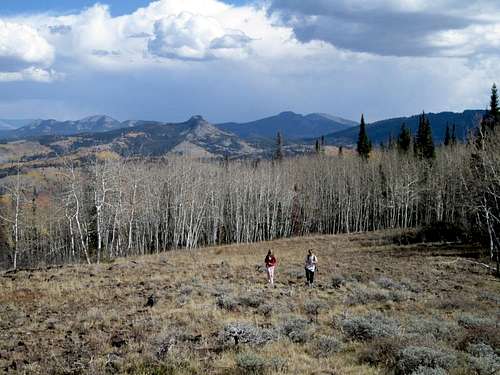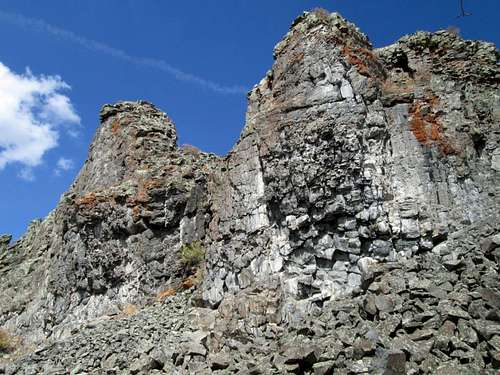|
|
Mountain/Rock |
|---|---|
|
|
40.81980°N / 107.2611°W |
|
|
Routt |
|
|
Hiking, Mountaineering, Trad Climbing, Toprope, Bouldering, Scrambling, Skiing |
|
|
Summer, Fall |
|
|
9565 ft / 2915 m |
|
|
Overview
Sawtooth Mountain is not one of the highest mountains in the Elkhead Mountains. In fact, you look down on the mountain when driving to the trailhead. That doesn’t mean that it’s uninteresting though. The long southeast ridge of the mountain is an impressive volcanic dike with vertical sides. The jagged appearance of the dike gives the peak its name.Sawtooth Mountain is likely very seldom climbed and there was no register or cairn on our ascent on September 29 2012. The mountain has undoubtedly been climbed before and the western most extent of the ridge does have a cairn.
The volcanic dike of Sawtooth Mountain is fairly solid and thus far, with the possible exception of Saddle Mountain, makes the only reasonable location in the Elkhead Mountains for technical rock climbing. “Fairly solid” is a relative term though and loose rock is still present in places. The boulders surrounding the dike would be good for bouldering as well.
Several aspects of the Elkhead Mountains make this a rather unique mountain range in Colorado. It is certainly possible that the Elkhead Mountains are the least known of the major mountain ranges in Colorado. This is partially because the range is a long way from any metropolitan area, and partially because the Elkhead Mountains are fairly low by Colorado standards, as there are no peaks reaching 11,000 feet. There are also few lakes, so the range isn’t visited by fishermen. Despite their low altitude, the Elkhead Mountains receive much snow, and snow lasts into July or later on the higher peaks. Most of the peaks in the Elkhead Mountains see very few ascents, but Hahns Peak, the eastern-most peak in the range is a popular climb for residents of Steamboat Springs. The Bears Ears see quite a few ascents by Elkhead standards, because of their prominent shape and visibility from the Yampa River Valley. Black Mountain is also climbed fairly often because it is the highest point in Moffat County, and the popularity is on the increase with more county highpointing interest. Sand Mountain must be a fairly popular (by Elkhead standards) climb as well, as there is a trail to the top, and as it is the first and only mountain in the range where I have ever met anyone. This was on Labor Day weekend, 2005, when we saw 3 other hikers. Most of the rest of the peaks see few ascents, and one ranger has told me some of the peaks only have a few names in the registers since 1980. So, there are few hikers around, but hunting is another story. The Elkhead Mountains are very popular for hunting in the fall and contain large populations of deer, elk, bear, etc.
One thing unique about the range is that hiker use is overall actually decreasing, rather than increasing as it is in most places in Colorado. The summit registers (which the Forest Service keeps record of) on most peaks indicate that they have had more ascents in the 1960’s and 1970’s than they do now. Even before that, there were many summit logs from the 1930’s and 1940’s from sheepherders.
The Elkhead Mountains are made of old volcanic rocks 17-25 million years old. One thing unusual is that the Elkhead Mountains run west to east as opposed to north and south as most of the ranges run in North America. It is impossible to describe the general forms of the peaks because they are all so different, but most of the peaks are isolated rises from a huge plateau which forms the bulk of the Elkhead Mountains.
Getting There
Sawtooth TrailheadFrom the junction of Highway 40 and 13 in Craig, turn north on Highway 13. Drive north for about 13 miles to north of mile marker 102 until you see a sign posted for County Road 27. The road is posted for “Forest Service Access” and “Black Mountain”. Drive County Road 27 through private lands for 10 miles which is where you reach the Routt National Forest boundary. The road becomes FR 110. From the Forest Boundary, follow FR 110 for 9.7 miles to FR 116. Turn right on FR 116 and drive 2.5 miles to a four way junction with FR 116, FR 1161 and FR 159. Turn right and follow FR 159 to its end. The road is rough in places, and is considered to be a 4wd road, but should be passable to high clearance vehicles such as Subarus if you drive slowly. Passenger cars will have to park early, perhaps two miles from the trailhead.
If you take the right fork at the last junction you will reach a turn around which might make an alternate trailhead west of the Bears Ears.
Lost Park Trailhead
From the junction of Highway 40 and 13 in Craig, turn north on Highway 13. Drive north for about 13 miles to north of mile marker 102 until you see a sign posted for County Road 27. The road is posted for “Forest Service Access” and “Black Mountain”. Drive County Road 27 through private lands for 10 miles which is where you reach the Routt National Forest boundary. The road becomes FR 110. From the Forest Boundary, follow FR 110 for 9.7 miles to FR 116. Turn left on FR110 and follow the road to the Lost Park Trailhead, which is 0.1 miles before the Lost Park Ranger Station.
Navigational Warning
Warning:None of the maps available show the roads (and there are no trails) in the area accurately. The closest one that bears resemblance to reality is the Forest Service Map-Routt National Forest, but even that one has a note on the access road that reads “approximate location only". The USGS maps do not show the last road to the trailhead at all. The USGS maps don’t show some of the other roads in the area as well, but seem to show roads and trails that don’t exist; at least not any more.
Update:
The USGS has (finally) updated the 7.5 minute maps. They were scheduled to be produced for Colorado last year, but I’m not sure when they will hit all the stores. Right now you can get/see/print/buy the new 7.5 minute maps on My Topo.
The good news is that all the roads and trails are FINALLY accurate for the Elkhead Mountains (and undoubtedly other areas as well). After receiving the new maps, I am very pleased to see that the roads and trails are in the right places. I am also very pleased that the USGS has a new agreement with the US Forest Service and within the national forest service areas, the private land holdings are shaded (but only in USFS areas, land ownership is not shown outside FS lands) on the 7.5 minute scale maps.
Map:
The 4wd Road and east side of the Bears Ears Trail does not show up on the topo map, so they have been drawn in at the approximate location.
Red = 4wd Road.
Purple = Trails.
Orange = Off trail routes.
Routes Overview
Southeast Ridge via Sawtooth TrailheadThis route offers the shortest way to climb Sawtooth Mountain. From the Trailhead, Trail 1144.6 is followed east until it reaches the well marked Bears Ears Trail/Trail 1144. The Bears Ears Trail is followed Northwest before you leave the trail near Sawtooth Park and follow the base of the dike to the summit.
This route is class 2 and is about four miles round trip.
See the route page for details.
Southeast Ridge via Lost Park Trailhead
This route offers a slightly longer approach to the mountain. From the trailhead, the Bears Ears Trail is followed east to Sawtooth Park where it intersects the route described above.
This route is class 2 and about six miles round trip.
Rock climbers can choose any route on the dike that they want.
Red Tape
No permits are required. There is no red tape here, so make sure to use LNT principles.Camping
There are many informal campsites along the road to the trailhead after you reach the forest boundary. The Sawmill Campground is quite a ways west of the trailhead and now cost $10. It is the only official campground in the area.The trailhead has a fair campsite, but a better campsite is located on the road just short of the trailhead.
Sawtooth Park also makes a nice campsite.
When to Climb
July through early September could be considered the normal season to climb the mountain. The access road usually doesn’t open until July, and it would be a really long walk in the winter.The Elkhead Mountains are a very popular hunting destination in September and October (until snow closes the road), so use extreme caution at this time of year. In winter or spring, this would be a very long trip unless you have a snowmobile.
Mountain Conditions
CLICK HERE FOR THE SAWTOOH MOUNTAIN WEATHER FORECASTBelow is the National Weather Service Climate Summary of Dixon/Baggs, on the Wyoming/Colorado border. The data is from 1922-2005. This is the closest long term weather station, but be aware that higher elevations will be much wetter and colder. Dixon/Baggs is at 6370 feet elevation, so expect the temperatures on Sawtooth Mountain to be 10-15 degrees colder than in Dixon/Baggs (except for on winter nights).
| MONTH | AVE HIGH | AVE LOW | REC HIGH | REC LOW | AVE PREC (in) |
| JAN | 32 | 3 | 55 | -55 | 0.89 |
| FEB | 36 | 8 | 61 | -47 | 0.72 |
| MAR | 43 | 16 | 75 | -31 | 0.96 |
| APR | 56 | 27 | 84 | -9 | 1.14 |
| MAY | 67 | 34 | 93 | 9 | 1.18 |
| JUN | 76 | 41 | 96 | 20 | 0.94 |
| JUL | 83 | 47 | 99 | 30 | 1.07 |
| AUG | 81 | 45 | 100 | 26 | 1.12 |
| SEP | 72 | 36 | 92 | 1 | 1.04 |
| OCT | 61 | 27 | 82 | -9 | 1.23 |
| NOV | 44 | 16 | 77 | -26 | 0.80 |
| DEC | 35 | 3 | 62 | -39 | 1.02 |









